Poland’s Dunkirk
In September 1939, the Polish armed forces had battled the Germans for two weeks before being blindsided by the Soviet Union’s attack from the east. With only minimal help from Poland’s allies, France and Great Britain, and with most of his forces fighting the Germans, Poland’s commander-in-chief Marshal Edward Smigly-Rydz ordered his soldiers in eastern Poland to withdraw south into Romania or Hungary, hoping to save them for future battles. By the end of the month, some 90,000 Poles had made their way into those two countries. Another 30,000 members of the Polish Army and Polish Air Force escaped the Red Army and the German Army by crossing the border into Latvia and Lithuania where they were disarmed and interned. Their subsequent escape to Finland later came to be called Poland’s Dunkirk. To those 30,000 Polish soldiers, it was nothing short of a miracle.
In 1939, Latvia shared a common border with Poland of some 100kms in length and the attack on Poland by Germany coaused widespread concern (as it did to a lesser extent in Lithuania). To fully understand the attitude of the Latvian Government to Poland and to the internment of Polish military personnel crossing into Latvia in 1939, we must briefly look at the international situation. In 1919 the Baltic states, Poland and Finland had started working intermittently towards creating an agreement for joint defense – we will cover this and other efforts in a subsequent post, suffice it to say that nothing concrete came from these efforts. Latvia’s subsequent attempts to create an alliance, at least with Estonia and Lithuania also came to nothing (the 1923 military convention concluded with Estonia was more of a formality than a concrete treaty, and an agreement in 1934 provided only a diplomatic cooperation, which in the years 1939-1940 did not lead to any solid military cooperation, giving the USSR, one of the pretexts it used for the occupation of the Baltic states in June 1940). Attempts to obtain a guarantee of independence from the Western powers also failed. In such circumstances, in early September 1939, the only hope of the authoritarian governments of the small Baltic states remained a policy of neutrality and respect towards the potential aggressors – the Germans and the Soviet Union.
Following the outbreak of war between Poland and Germany, Latvian President Karlis Ulmanis issued a statement on September 1st 1939 affirming the neutrality of Latvia, and on September 3rd the government once again stated: “In this troubled time the government kindly requests all citizens to dutifully and unanimously support the policy of neutrality determined by the President of the State, which the Government will implement in all areas of business. Calmly and with dignity, without giving anything away and not giving in to panic, the whole nation will continue its work and will overcome all the difficulties and limitations that war between foreign states can also bring to our land. The sense of responsibility and sense of duty should be strong in every citizen, and everyone should know that the government expects an active and judicious support from all citizens. We will work together, to pray for peace for the peoples who today raise weapons one against another, and together we will give all our strength to strengthen and honor our homeland. God, bless Latvia! “
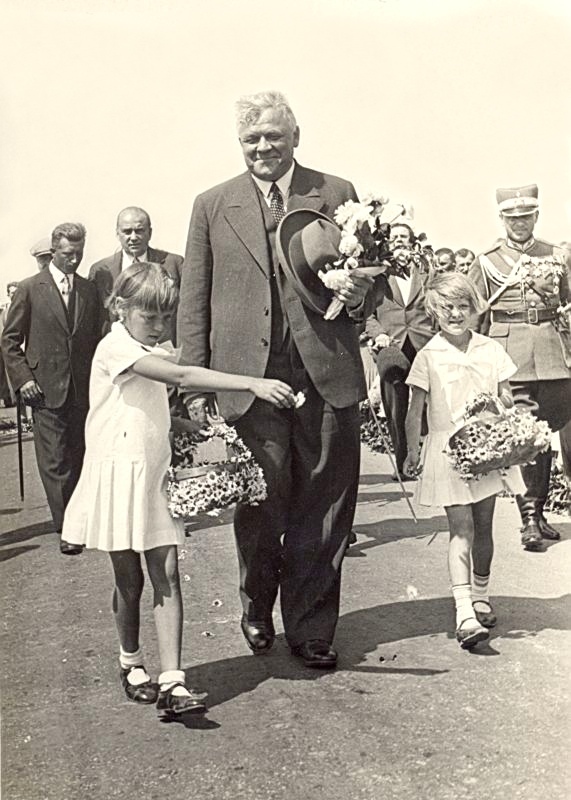
Latvian President Karlis Ulmanis
Latvian President Karlis Augusts Vilhelms Ulmanis: (born September 4, 1877 in Bērze, Bērze Parish, Latvia — died of dysentery September 20, 1942 in Krasnovodsk prison, Soviet Union) was a prominent Latvian politician in independent Latvia from 1918 to 1940. Ulmanis studied agriculture at the Swiss Federal Institute of Technology Zurich and at Leipzig University. He then worked in Latvia as a writer, lecturer, and manager in agricultural positions. He was politically active during the 1905 Revolution, was briefly imprisoned in Pskov, and subsequently fled Latvia to avoid incarceration by the Russian authorities. During this period of exile, Ulmanis studied at the University of Nebraska-Lincoln in the United States, earning a Bachelor of Science degree in agriculture. After working briefly at that university as a lecturer, Ulmanis moved to Houston, Texas, where he had purchased a dairy business. Ulmanis returned to Latvia from exile in 1913, after being informed that it was safe to return due to the declaration of a general amnesty by the Russian tsar. This safety was short-lived WWI broke out one year later.
Ulmanis was one of the principal founders of the Latvian People’s Council (Tautas Padome), which proclaimed Latvia’s independence from Russia on November 18, 1918. Ulmanis was the first Prime Minister of a Latvia which had become independent for the first time in 700 years. He also served as Prime Minister in several subsequent Latvian government administrations during the period of Latvian independence from 1918 to 1940. In addition, he founded the Latvian Farmers’ Union, one of the two most prominent political parties in Latvia at that time. On May 15, 1934, in order to protect the country from a coup by right-wing extremists led by Lt. Col. Voldemārs Ozols, Ulmanis as Prime Minister dissolved the Saeima (Parliament) and established executive non-parliamentary authoritarian rule. Officers from the Army and units of the Aizsargi loyal to Ulmanis moved against key government offices, communications and transportation facilities. Many elected officials were illegally detained, as were any military officers that resisted the coup d’etat.
Ulmanis was a popular leader, especially among the farmers, during whose leadership Latvia recorded major economic achievements. During Ulmanis’ rule, education was strongly emphasized and literacy rates in Latvia reached high levels. The United Kingdom and Germany became Latvia’s major trade partners, while trade with the USSR was reduced. The economy, especially the agriculture and manufacturing sectors, were micromanaged to an extreme degree. Ulmanis nationalized many industries and there was rapid economic growth, during which Latvia attained a very high standard of living. At a time when most of the world’s economy was suffering, Latvia could point to increases in both gross national product and in exports of Latvian goods overseas. This, however, came at the cost of liberty and civil rights. Ulmanis was a Latvian nationalist, who espoused the slogan “Latvia for Latvians”. As the result, the economic share of minorities – Germans, Jews, Russians, Lithuanians – declined. However, Ulmanis didn’t allow any physical violence or unlawful acts towards minorities and dealt harshly with right- and left- wing extremists, and with both Nazi and Communist sympathizers Latvia was also open to refugees and many from both Germany and the USSR found refuge in Latvia between 1920 and 1938.
In June 1940, when Latvia was completely occupied by the Soviet Union, Ulmanis ordered Latvians to show no resistance to the Soviet Army. The phrase “I will remain in my place and you remain in your places” from his radio speech on this occasion is still famous. On July 21, 1940 Ulmanis was forced to resign and he then asked the Soviet government for a pension and to allow him to emigrate to Switzerland. Instead, he ended up in Stavropol in the USSR, where he worked in his original profession for a year. In July 1941, he was imprisoned. A year later, as German armies were closing in on Stavropol, he and other inmates were evacuated to a prison in Krasnovodsk in the present Turkmenistan. On the way there, he contracted dysentery and died on 20 September 1942. His grand-nephew, Guntis Ulmanis was elected President of Latvia in 1993.
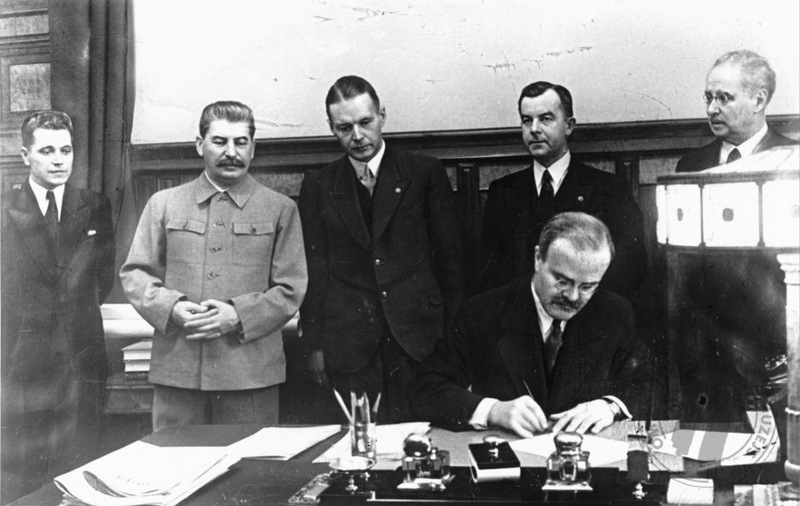
The signing of the Latvia-USSR Mutual Assistance Pact in Moscow on 5th October, 1939. The signatories: Seated, Molotov. Standing (from left): USSR political representative to Latvia I. Zotov, Stalin, the Latvia Foreign Minister Vilhelms Munters, the Latvian envoy to the USSR Fricis Kocins and the USSR’s First Assistant Foreign Affairs Commissar V Potjomkin.
Although in some publications, the press (especially in the first week of the war) expressed not-so-well-hidden sympathy for the Poles, officials and newspapers tried to maintain a strict neutrality. For example, on September 1, Polish MEP S. Klopotowski gave an interview to the Latvian press, but the Foreign Ministry prohibited its publication, giving the press a hint that in the case of similar interviews, the text must be agreed to by the Ministry of Foreign Affairs prior to publication . On September 4th the PAT Correspondent in Riga approached the Director of the State Telegraph Agency, indicating that the Polish press office would provide the latest news about the war to the Latvian press. The Director politely replied that “given the neutral position, we will supply only official announcements”. Simultaneously the Latvian government through diplomatic channels desperately tried to determine the basis of rumors of the liaison pact between Germany and the USSR which had been made on August 23. The Baltic states, however, received only vague answers from the representatives of both countries.
Meanwhile the Latvian-Polish border was not entirely peaceful. From the beginning of September, Poles had begun seeking refuge in Latvia (few were returned back) and Latvia Poles were crossing the other way, seeking to join the Polish Army. Polish border guards by September 3rd had already sent back to Latvia two young Poles from Daugavpils (Daugavpils), who wanted to join the Polish Army (other Polish-Latvian volunteers made it to Wilno). This situation changed abruptly on September 17th, when hundreds of refugees began flooding into Latvia. In a meeting of the government, a proposal was made by President Ulmanis and the Foreign Minister V. Munters to suspend diplomatic relations with Poland. On September 21 Munters invited the Polish envoy, Kłopotowskiego to a meeting and read him the note. Trying to ease the tenor of the note, Munters advised that ” if the Polish government will start operations again, then – we’ll see what comes next”, but the conversation “was a tragic moment”. On the same day (21 September) in accordance with the Foreign Ministry statement that “relations with the Polish military attaché have been interrupted” – the Polish embassy was refused a permit for an attaché, Major F. Brzeskwińskiego, to visit the internment camp for Poles that had been set up.
In attempting to placate Germany and the USSR, Latvia had ceased to be a neutral party. In turn, the governments of Estonia and Lithuania were placed in a similar situation. Polish relations with both Lithuania and Latvia were interrupted in a milder form in October. Other neutral countries, especially Scandinavian countries, had not considered this possibility and the Polish delegations continued their diplomatic work. The Latvian Government and Foreign Ministry on September 25 justified this step to representatives of Britain, and later to France, both of whose representatives gave expression to their displeasure. The Polish embassy building in Riga and the Polish consulate building in Daugavpils were at this stage taken over by representatives from Finland, who quickly acted to set up a Polish affairs section and from which they began to work to assist Poles in moving out from Latvia and Lithuania to Sweden and Finland. In early October (5 October) Latvia was forced to sign an agreement with the Soviet Union, authorising the deployment of Soviet garrisons. The number of soldiers in the Soviet military garrisons was close to or even exceeded the number of soldiers of the national armies of each of the Baltic states. However, by the time the Red Army garrisons actually arrived, Finland had already acted and the Poles at least were gone.
Internment
On the evening of September 17 the flood of Polish refugees crossing the border began in earnest. Rail traffic was stopped between stations in Poland and Latvia and on September 18 border security in the region was strengthened with local aizsargów (members of the paramilitary Aizsargi). Refugees gave the Latvian officers weapon. One of the interned Poles, M. Zawiło, recalled that the border had been strengthened and that “we could see a lot of cavalry and infantry patrols on the railway line. Poles gave up their arms and ammunition. The railway station waiting room had several tables where the personal data of Polish soldiers was recorded. Then we were taken to Daugavpils in passenger cars. At the border taking pictures was strictly forbidden, the whole area was closed to civilians.”
On September 18 and 19 83 Polish aircraft arrived and the crews were interned: these aircraft consisted of 38 RWD-8, 35 PWS-26, 1 PZL-11A, 2 RWD-10, 2 RWD-17 RWD-21 1, 2 Lublin R XIII, 1 R XIIIC Lublin, Lublin R-XIV 1. Mostly these were training aircraft from north-eastern Polamd, which in the first half of September centered on Wilno. The only combat units that arrived were 3 RWD-8’s from Pinsk. Aircraft landed at the airport in Daugavpils, but in some cases it was necessary to use anti-aircraft artillery fire and machine guns to force the aircraft to land. On September 19 an aircraft which did not want to land and flew of in the direction of Jēkabpils was shot down near Daugavpils. Afterwards, 20 RWD-8’s were used as instructional aircraft in the Latvian Army aviation regiment, and six aircraft were handed over to Aeroklubowi Latvia, while several went to the Aviation Aizsargi. The greater number remained in warehouses in Riga.
Correspondent daugavpilskiej “Daugavas Vēstnesis” was in Wilno in September. On the morning of 18 September he was at the Wilno airport and observed the situation. There was nervousness, the weather was not favorable, but some pilots flew to Latvia. Shouts accompanied each aircraft flying out. At least four pilots flew together with their wives. The airmen interned mostly came from the fifth Lida Aviation Regiment, some from the fifth Regiment in Torun, some from the Wilno flight school and a few from the 1st Aviation Regiment. They were relatively well armed. The number of pilots along with the technical personnel of air regiments escaping to Latvia reached several hundred people. The same correspondent describes the situation of Polish refugees on the Polish-Latvian border, which he witnessed: “When I arrived at the Zemgale station there remained in the Polish side a long line of cars, and many refugees. It did not last long. By September 21 the influx of refugees was over, but there had as yet been no contact with Red Army Border Protection units.” The border was closed by Soviet units on the evening of September 22, by which time many thousands of Poles, both military and civilian, had sought refuge in Latvia.
The official registration and the initial internment work took place in Daugavpils where refugees received medical care. Refugees behaved calmly and seemed reconciled to their fate. By September 20 most of the first arrivals had been sent to the newly formed camp in Liepaja, later many were sent to camps in Sigulda and Valmiera. The camp in Daugavpils was temporary, with Liepāja becoming the main internment centre. Further camps were set up at Liten and Lilaste and the Latvian military assigned one company of Aizsargi to supervise each camp. (When the time came for Finland to act, this facilitated the evacuation as the Finnish Suojeluskuntas had close ties with the Aizsargi and these ties were used from the start). By October 7th no refugees remained in Daugavpils.
Within the internment camps, good order prevailed. Wake-up call was scheduled for 7.00, followed by breakfast, working, learning, walking in the courtyard from 9:00 to 12:30 pm and later – lunch, after which there was free time for dinner (18.00) and then at 21.00 the call for evening, and from 22.00 lights out. On holidays, waking up was an hour later. Officers and others – each in their own particular time could bathe in the lake in the territory of the camp, but the water temperature was to be no lower than 18 degrees (a doctor measured the temperature at 7.00 in the morning). Radio could be listened to in the camp throughout the day. In the Liepaja Camp, Col. E. Perkowicz served as senior officer, and received orders directly from the Latvian camp commander. Already by early October there was offered the opportunity to learn Latvian, Russian, English, German and French, to continue their primary and secondary education, participation in agricultural courses, drainage and cultivation of bees. Playing of sports was encouraged (the Latvian Red Cross donated for this purpose footballs, skates, as well as chess, checkers and dominoes).
Guests could visit every day from 12.00 to 20.00. Within one week you could send a post card at no charge (postage was paid by the International Red Cross). Those who in Latvia had friends or relatives were able to leave camp two times a month, to get 2 days off to visit family in Sigulda, a civilian refugee camp, or to visit relatives in Riga (once per month). In fact, the internees, regardless of whether they had relatives in Latvia or not, got leave frequently. Everyone had to sign a declaration that outside of the camp they would behave impeccably and that in the event of default all internees would loose the right to leave. From 11th of October 1939 the internees were allowed to meet with people who were their spouses, relatives or relatives of their spouses, but – judging from the entries in guest books – to obtain a formal statement of the meeting was enough to establish a relationship with the internees.
Starting as early as 21-22 September, the Latvian authorities began to pay interned Polish Officers and NCO’s. The Latvian Polish community also banded together to help the internees. Some internees began plans to escape while the Latvian government debated what to do with the Polish internees. According to the Polish military attache in Lithuania, Leon Mitkiewicz, he received an instruction from General Mieczyslaw Norvid-Neugebauer on 23rd September, 1939, instructing him to send large groups of the internees to France …… by railroad. Mitkiewitcz recorded that the instruction was somewhat naive and he had some doubts about the geographical knowledge of the author of the instruction. Needless to say, it was not complied with. Between September 10th and October 15th about 400 internees got French and British visas, but only about 150 managed to leave, all via Sweden. The Swedish Government was very reluctant to give visas, even for transit.
However, unknown to the Polish internees in Latvia and Lithuania – and to the British and French Governments and the Polish Government-in-Exile, such as it was in late September and early October 1939, Finland was already planning the evacuation of the Poles in Latvia and Lithuania for her own reasons. As has been previously noted, Finnish Intelligence (and key Government Ministers and senior Military Commanders) were aware of the secret protocols of the Molotov-Ribbentrop Pact, of which they had been made aware from two sources – a sympathetic source in Germany (where Finland had many well-wishers) and also personally to the Finnish Ambassador in the US from US President Roosevelt himself. After the immediate invasion of Poland and the Soviet pressure on Finland and the Baltic States, Finland took this seriously and was moving rapidly to a full war footing. As such, 25-30,000 Polish military personnel were a valuable asset, either as additional soldiers should that eventuate or as additional leverage with the British and French. Not that the Finns counted on this, just as they did not count on Stalin’s goodwill and his abiding by any agreement signed.
Escape – Poland’s Dunkirk
Thus the decision to act. In the decade of the 1930’s, the Finnish Navy, the Merivoimat, had made considerable progress, both in size and in the ability and capability to plan and act rapidly. On the 20th September 1939, the Finnish Government instructed the Navy to begin planning for the evacuation of Polish military personnel from Latvia and Lithuania in a rapid and secret move. Reserve personnel for the Merivoimat, including the three Rannikkojääkärit Regimental Battle Groups, had already been mobilized and thus additional troop and ship movements were not surprising. Scattered in various locations, a number of cargo and passenger ships departed Finland on the evening of 13 October 1939 and steamed south at an average speed of 20 knots. They had been preceded by five Merivoimat Submarines who were already well on their way and who were instructed to protect ship movements against any hostile acts, with force if necessary. Early the next morning (14 October), a naval task force consisting of four of the Merivoimat’s Grom-class destroyers, six of the fast ASW Corvettes and some twenty five Motor Gunboats headed south at thirty five knots, linking up south of the Aland Islands and continuing as a single force. By nightfall on the 14th they had joined the cargo and passenger ships off the Latvian coast and in the early evening, they began to enter Latvian waters and dock.
Starting in the early evening on 14 October 1939, covert operations soldiers of the Finnish Intelligence Service based from the Finnish Embassies in Lithuania and Latvia began to activate the plans that had been prepared with their paramilitary contacts in Latvia and Lithuania. Trucks and Buses packed with Poles from the internment camps began to roll down the Lithuanian and Latvian roads, with convoys of trucks passing through the Lithuanian border without checks or hindrance as they headed north. Confused Poles began to be packed into Finnish ships as Marines of the Rannikkojääkärit units moved ashore in local displays of force – just in case any misguided Police or local Army units attempted to intervene. At the same time, the Finnish Ambassadors in each country paid a midnight call on the respective Presidents and advised them that in six hours there would no longer be any issues they need concern themselves with over Polish internees. The high-handed Finnish move was not welcomed, but neither was it resisted.
One of the Polish soldiers who escaped from Latvia in the Evacuation was Henryk Wroblewski, a serving member of the Polish Air Force. Henryk was born in St. Petersburg in 1921. His mother was a maid in the household of a Russian general, his father was a member of the Czar’s Palace Guard. Although his father had been regarded as too old to fight in 1914, the Bolshevik Revolution in 1917 persuaded the family to return to Poland. In 1922 when Henryk was aged one, the family settled in Wilno.
Here is Henryk’s account of what would come to be known as “Poland’s Dunkirk”:
(see http://www.polandinexile.com/henry.htm for the real story…)
“On the 17th September 1939, early on a Sunday morning, Soviet Russia invaded Poland. A small Polish unit was leaving town (Wilno). With a few of my colleagues from the Air Force, we joined this unit as volunteers. Equipped and armed, we marched west, but did not get very far as Soviet troops had cut us off. On 20th September we decided to cross the Latvian border where we knew we would be interned. We were dis-armed and interned temporarily in a barbed-wire surrounded camp at Dyneburg.
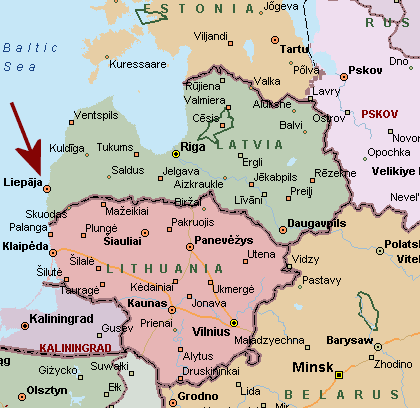
Liepaja: the Latvian Port from where some 20,000 of the 30,000 Poles in Latvia and Lithuania were evacuated on the morning of 14th October 1939 in a well-planned and organized operation by the Merivoimat.
After a few weeks I was sent to a camp at Liepaja, a port on the Baltic Sea, where there were about 8,000 Poles from all the services. At the camp, we were well treated by the Latvian guards, but there was little to do. We all knew about the demanded from the USSR that the Baltic countries allow the USSR to establish military bases and station troops on their soil for the duration of the European war and this worried us – we had heard many stories about what was happening back in Poland. Latvia signed an agreement on 5 October 1939 that gave the USSR bases at Liepāja, Ventspils, and Pitrags and allowed the Red Army to garrison 30,000 troops in Latvia as well as build airbases and that really worried us. We all wanted to somehow get to France or Britain where we had heard Polish military units were being reformed. But we had no contacts and no way that we knew of to escape from Latvia.
Things changed for us very suddenly on the morning of 14th October 1939. At 1am in the morning, we were woken by men of the Aizsargi, the Latvian “Guards” organisation and told to assemble with whatever we possessed. At 3am, the Aizsargi began directing us on to an assortment of trucks and buses while other groups were started off on foot. We were told we were being taken to the Port area from where we would be shipped out of Latvia. Lots of rumours flew around as we moved out, among them that we were being shipped off to Germany or the the USSR, but nobody panicked and tried to run – there were a lot of Aizsargi, and they were all armed and besides, where could we go? In my case, I was lucky enough to be packed into a truck – standing room only – so at least I didn’t have to walk like many of the others did.
We got to the port and were driven directly onto a wharf next to a large ship. We were told to get off the truck and line up with the others already waiting and we did, after which the truck left immediately and the next took its place. There were some large groups of men stationed along the wharf at intervals in strange looking uniforms and armed with rifles and submachineguns that were different from anything we had seen. They wore German style helmets which caused a certain amount of concern, but the rest of their equipment was unlike anything we’d seen in photos of Germans or of the Red Army. We wondered who they were and rumours flew around that it was the Swedes or the British or even the Americans. We’d only been there 5 minutes, and head of us we could see rows of men filing up gangplanks onto the ship. Further down, we could see another ship and then another with the same thing happening. It seemed every Pole in Latvia was there. Which was not quite correct as it turned out – it was every Pole in Lithuania plus all of us that were at the camp outside the city.
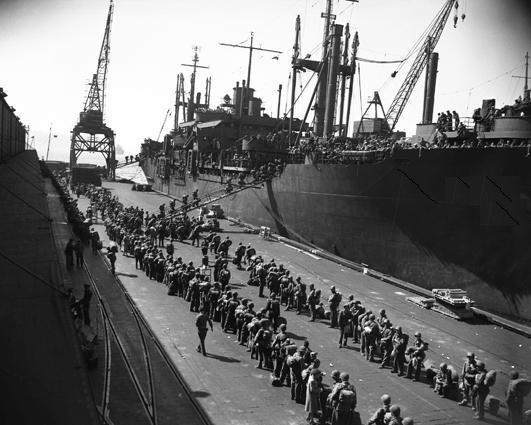
Polish soldiers lined up on the wharves at the Latvian port of Liepaja and filing aboard Finnish transport ships. Operatives of the secretive covert action wing of the Finnish Intelligence Service coordinated the move with the Latvian Aizsargi and Lithuanian paramilitary organisation, the Lietuvos Šaulių Sąjunga. Some 30,000 Poles were moved over a period of two days from Camps in both Latvian and Lithuania to the Latvian ports of Liepaja, Ventspils and Riga, from where they were embarked on Finnish transports. Loading started at midnight on 14th October and had been completed by midday on the 15th, after which the ships were on the move.
We could see the group next us was being addressed by someone in wearing that German style helmet, after which they started to move onto the ship and then he walked over to us. Every eye was on him. He started to address us in very badly accented Polish. Very very badly accented and very broken Polish, Well, he might not have spoken good Polish but his first words bought a huge relief to all of us. “We are from Finland. All of you keep quiet and listen.” He had that sort of Senior NCO voice that commands instant obedience. Even in bad Polish! Nobody made a sound. “You will make No Noise. There Will Be No Questions. Listen and follow instructions. I am from the Finnish Navy and we are here to evacuate you to Finland. From this moment you are under the protection of the Finnish Navy. You will board the ship as instructed and take the places you are told. Do it quickly and do not argue. Follow all instructions. We are sailing for Finland as soon as everybody is safely on board. We must move quickly before the Germans or the Russians become aware of what is happening.” He gestured to the man standing next to him. “Ylivääpeli (that’s Master Sergeant to you) Sinkonen will take over and see you onto the ship. Do not argue with him, he does not speak Polish.” “Neither do you,” I thought but didn’t say. Without any further words he turned and moved on to the next group.
Ylivääpeli (we eventually got used to Finnish ranks but it took a long time) Sinkonen looked at us and smiled. He was 6 feet six and looked like he could carry a pine tree under either arm. His smile might have been friendly, it was hard to tell. While he did not speak Polish his instructions were obvious. We fell in at the rear of the group ahead of us and filed up the gangplank and onto the ship as fast as we could. There was no delay. Finnish sailor’s were every few feet and they pointed and pushed us in the direction we were to go in. The ship must already have been fairly full. We were directed upwards and then packed into cabins. It looked like a passenger ship, maybe a ferry of some sort and we were packed in like sardines. Nobody complained. There was not one protest – we were all elated that we were leaving Latvia although at this stage we had no idea what the future would bring. But at least we knew Finland was friendly to Poland and we would not fall into the hands of the Russians or the Germans. There were 30 of us packed into a small cabin with 6 bunks but at least we had a porthole that could open and let fresh air in. Two hours after we had boarded, the ship began to pull away from the berth and head out to sea. From our porthole, we could see other ships as crowded as ours, even the decks were packed and we could see warships as well. “Finnish destroyers,” someone said as one raced past us, visible through our small porthole. Because it was getting lighter, we could make out the large Finnish flag and see that all the guns were manned and it was ready to fight. That was very reassuring.
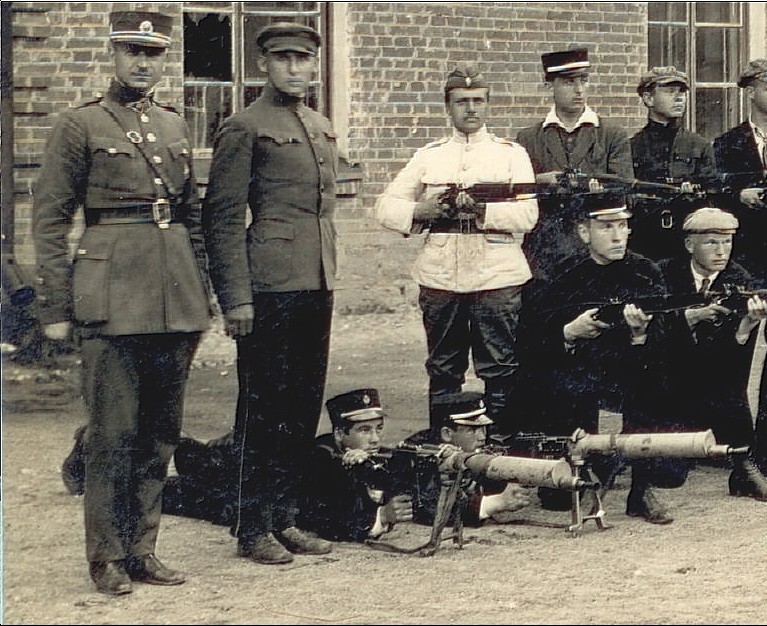
Lithuanian Men of the Lietuvos Šaulių Sąjunga (photo from 1926)
Lithuanian Men of the Lietuvos Šaulių Sąjunga (photo from 1926): The Lithuanian Riflemen‘s Union was a nationalistic paramilitary organisation similar in many ways to the Finnish Suojeluskuntas (and indeed, in the interwar decades had established ties with the Suojeluskuntas). Being a member was seen as prestigious, and a “šaulys” was regarded as a defender of the state, with many state officials such as Police and Foresters being members of this organisation, which was some 60,000 strong in the 1930’s. Following the Soviet occupation of June 1940, many members of the Lietuvos Šaulių Sąjunga would pay with their lives for the assistance they had given to the Poles in escaping to Finland.
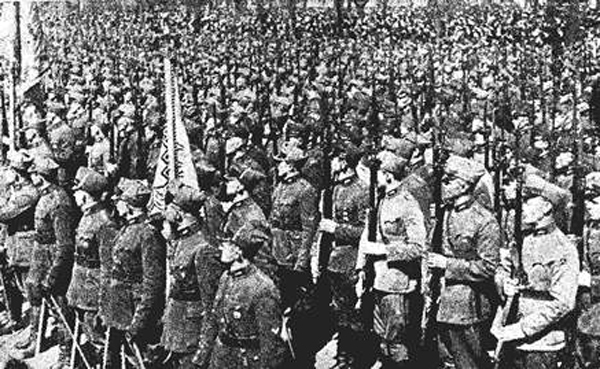
Latvia: Men of the Aizsargi (Guards) paramilitary organisation. As in Lithuania, many of the Aizsargi that helped the Poles escape paid with their lives after the Soviet occupation. Some would escape to Finland before the Soviet vice clamped down irrevocably, and the Finns would clandestinely rescue many between June and September 1940 as well as over the period of the Soviet and German occupations. These men would become the core of the Latvian Regiments that would fight in the Maavoimat-led Liberation of Latvia in 1944.
Shortly after that the ship picked up speed and we could see the other ships moving with us. Passenger ships crowded with fellow Poles, Destroyers and small fast warships of some type we had never heard of – but they were very fast – moved with us. We could feel the ship’s engines vibrating the whole vessel and it seemed like she was going as fast as she could. It was a wonderful feeling and everybody was talking – at least until the sea got rougher and some started feeling seasick. Shortly after, the same Finnish Senior NCO who could speak Polish stuck his head in our cabin. “Listen,” he barked, and we all fell silent. It was that tone of voice again. “It will take us twenty hours to get to Finland. We will bring food and water round later, but there are 2,500 of you on a ship built to carry 700, it will take a while. In meantime, you stay in your cabins. There are bathrooms down the passageway. Only leave to use them and come right back. There is no room for anyone to wander around. A sailor is on duty in the passageway to make sure you obey. He does not speak Polish so don’t bother asking him anything. I am only Finn on this ship that speaks Polish and I have all of you to talk to. Don’t waste my time asking questions. All I know is we take you to Finland with your Government’s agreement.” He looked around. “Do not make trouble on this ship. You will not enjoy the results.” Then he smiled at us. “Finland will welcome you.”
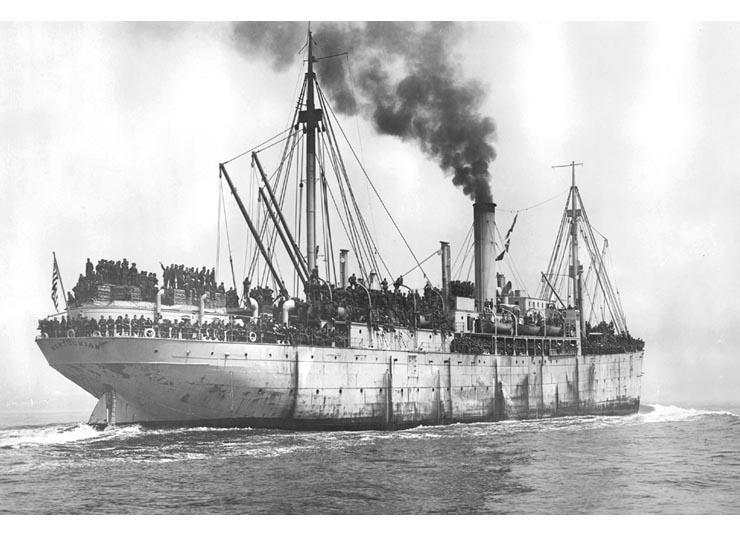
Polish soldiers being evacuated from Latvia and Lithuania to Finland – packed into and onto Finnish transports and escorted by almost the entire Merivoimat, 30,000 members of the Polish military were evacuated to Finland in a move that took both the Germans and the Soviets by surprise. It was a mammoth logistical and naval effort involving some 15-20 transport ships and 25 warships that took place with a flawless precision that was evidence of the complete professionalism and expertise of the Merivoimat. The Rannikkojääkärit Regimental Battle Group that supplied the “land force” component of the move operated with a precision and élan that reinforced this impression to any observers (of which, outside the Latvians, Lithuanians and Poles, there were none….).
Finland did. We had left Latvia early in the morning of the 15th of October and we arrived in Helsinki on the morning of the next day, all 30,000 of us in one day in a small convoy of fifteen passenger and cargo ships. God knows how the Finns had done it but us Poles, we were all elated. We had escaped! Tired as we were, we could not stop talking, nobody wanted to sleep, we all just wanted to find out what was happening and where we were to go. At last, after three hours sitting in our cabin and taking turns to look out the porthole, a real genuine Polish Officer stood in the doorway of our cabin, with a Finnish soldier next to him. He looked us over and grinned. “Welcome to Finland,” he said. “You are going to follow this NCO off the ship. The Finns have set up camps for us and you will stay there for now until we can arrange for you to be shipped out to Britain to join the Polish Army and continue the fight.” We all cheered, this was the best news we could imagine. After we quietened down, he continued, “It may take some time to organize, but in the meantime, do not cause any trouble and be on your best behavior. We are all guests here and the Finns have helped us more than anyone else. I have to go now to the next cabin but the NCO here will take charge of you.” He gave us another grin and left.
The Finnish NCO looked at us and said something incomprehensible, then gestured to us to follow him. We did, all thirty of us filing out of the cabin and following him through the ship like a group of school children on an outing. As we came onto the deck, we paused. It seemed like the entire population of Helsinki was lining the wharves and cheering. There were even Polish flags being waved. It was enough to bring tears to the eyes, and more than one of us was crying openly at the welcome. Filing down the gangplank, “our” NCO first led us towards a row of Field Kitchens and trestle tables staffed by rows of Finnish women in uniform with armbands that read “Lotta.” It was our first experience of the Finnish women’s paramilitary organisation, the Lotta Svärd. It would not be the last. We were handed large mugs of coffee and told to drink up, then given sandwiches to eat on the truck which we were promptly gestured to get in. From the back of the truck, we got a good look around as we were driven out of Helsinki and into the countryside, one of a long line of trucks and buses going in both directions – which seemed to indicate we weren’t going far.
Within the hour we were being offloaded at a Finnish military camp. Our group of thirty was allocated to three ten man tents with bedding. Our Finnish NCO remained with us, taking us to eat in a large mess hall which seemed to be serving food non-stop, then to a warehouse where we were issued with new clothing. “Our” NCO remained with us for the next two weeks, by which time we were being reorganized into “Polish” units. It was at that stage that I was moved into a Polish Air Force unit within the camp, saying goodbye to my Army comrades with whom I had made the trip from Latvia and spent my first two weeks in Finland. By then, we were all in love with Finland. While we were being reorganized, we were allowed out of Camp and we made a number of trips to Helsinki. The Finnish Army even paid us and the Finns in Helsinki welcomed us with open arms. It was difficult to even pay for a meal or a drink and we often found ourselves guests in Finnish houses. After Latvia and Lithuania, where we were tolerated but not welcome, it was a refreshing and invigorating change.
Peripherally, we were aware of the ongoing tensions between Finland and the USSR – and we none of us had any love for the USSR, which had stabbed Poland in the back as we fought the Germans. Thus, as tensions in Finland rose and we saw the Finnish military being mobilized and moving to the frontiers, with even women and teenagers armed and ready to fight, many of us asked our Officers what we could do to help the country that had rescued us. It was in early November as I recall that we were paraded as a unit and our CO told us that Finland had formally asked the Polish Government for our help – and that our Government had replied that any Pole who volunteered to fight for Finland could do so with their official blessing. The CO asked for volunteers to step forward and as one man, our entire “Squadron” moved forward. The situation was the same across every Polish Camp in Finland. With very few exceptions, we all volunteered.
 Copyright secured by Digiprove © 2013 Alternative Finland
Copyright secured by Digiprove © 2013 Alternative Finland


3 Responses to Poland’s Dunkirk